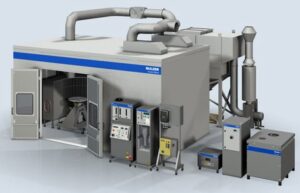Thermal Spray Dust Collection - Hood Design
Thermal spray operations utilize a dust collection system to manage over-sprayed compounds, these are some proven strategies for ensuring proper airflow design.
By Paul Richard, OEM Product Manager
Managing Over Spray
Proper System Design

Thermal spray dust control ventilation systems typically include ducts to transport dust- laden air to a dust collector and a fan to move the air through the system. An important part of the ventilation system design is the strategy used to capture dust in the thermal spray cell or booth itself. Simply increasing the airflow through the cell may not substantially increase the capture of dust, and this approach typically wastes energy. With an analysis of the cell’s layout, the makeup air source location, and the thermal spray target position, it is possible to dramatically improve the capture and exhaust of overspray dust.
System Design Considerations
First, consider the makeup air entering the enclosed thermal spray cell (booth). Ultimately, all the dust-laden (dirty) air removed from the booth by the dust collector must be replaced by air drawn back into the booth. Makeup air is either drawn through openings in the booth itself, or through a dedicated makeup air unit usually from outside the building that then delivers it straight to the booth through ducts. The design of the makeup air system can be critical to the design of the dust control system because it may cause the booth to be under negative (vacuum) pressure or positive pressure. A slight vacuum within the booth can help avoid unexpected positive pressure conditions while the dust collector is pulse cleaning. During pulse cleaning, short blasts of reverse air can cause slight increases in the pressure within the booth. This increase in pressure can potentially pop open an access door and accidently activate the safety limit switches on the door, which creates an inadvertent emergency stop of the spray process. Booth manufacturers should be consulted on the amount of vacuum that can be applied to their thermal spray cell.
Cross-ventilation Strategies
One strategy to manage airflow through the booth is to place makeup air connections opposite the air extraction points on the booth, creating a cross-ventilation flow pattern. However, since makeup air connections often incorporate sound attenuation devices (silencers), it generally makes sense to place the makeup air connections on top of the booth. Any connection strategy that can increase the possibility of establishing a cross-ventilation air flow pattern in the booth will be helpful in reducing the potential for dust buildup within the booth.
Downward Airflow & Plenum Design
Extracting dirty air from the booth can be done with a couple of airflow patterns: either downward or horizontal. Although downward airflow patterns work well in dust collector designs, they can present challenges in a booth design. In a booth with a downward flow pattern, the floor of the booth becomes a grated opening over a chamber, or plenum. Dirty air is pulled down into the plenum and through ducts to the dust collector. This design has the advantage of using gravity to help draw dust towards the collector and ensures virtually all overspray eventually is exhausted. The challenge is in keeping dust moving with air in that plenum below the floor. With proper design, dust can be successfully drawn through the plenum but, if the plenum design is not done well, dust will settle in the plenum and create a housekeeping challenge. In a downward flow booth, the velocity of air in the plenum cross section is often kept much higher than the downward velocity in the booth – often in excess of 2,500 feet per minute to ensure dust does not settle in the plenum. This requirement makes effective plenum designs challenging.
Downward flow booths must also be tall enough to allow space for the plenum underneath the floor. It is sometimes possible to use a pit beneath the booth, but booths and their plenums are generally installed above the shop floor.
Horizonal Airflow & Plenum Design
Considering Oddly-Shaped Stock
In some instances, oddly shaped targets require completely custom solutions. For example, the thermal spraying of cylindrical shapes on lathes can be particularly problematic. A downward flow booth designs may be a good strategy for dust control, but if a downward flow booth is not possible, short slotted hoods may work as well. The slotted hood takes advantage of a slot’s ability to distribute air extraction across a wide area, increasing the influence of air extraction across the full length of a lathe. These more complex extraction hoods should be based on the best practice designs in the Industrial Ventilation Manual, A Manual of Recommended Practice for Design, published by the American Council of Governmental Industrial Hygienists.
Considering Large Stock
Another challenge to dust control with thermal spray booths is the use of overhead cranes to move spray targets into and out of booths. Special booth designs with top openings are often used, but this can interfere with controlling make-up air locations. Although these obstacles may compromise perfect designs, they can often be managed within reasonable levels.
Open-Air Spraying Considerations
If it is not possible to completely enclose the spraying process within a booth, smaller hoods can sometimes be used as local exhaust ventilation where spraying is being done. Of course, any open air thermal spraying must be properly reviewed to ensure compliance with environmental and health regulations.
Good Housekeeping
Summary
As with many industrial ventilation activities, local, state, or federal regulations may influence the design of a dust ventilation system so check with your governing authorities before finalizing your designs. You may also benefit from the assistance of a professional familiar with dust control design practices.

AST Canada has been helping clients find solutions for their unique Dust, Mist & Fume Collection needs for more than 40 years.
We can help you too.
